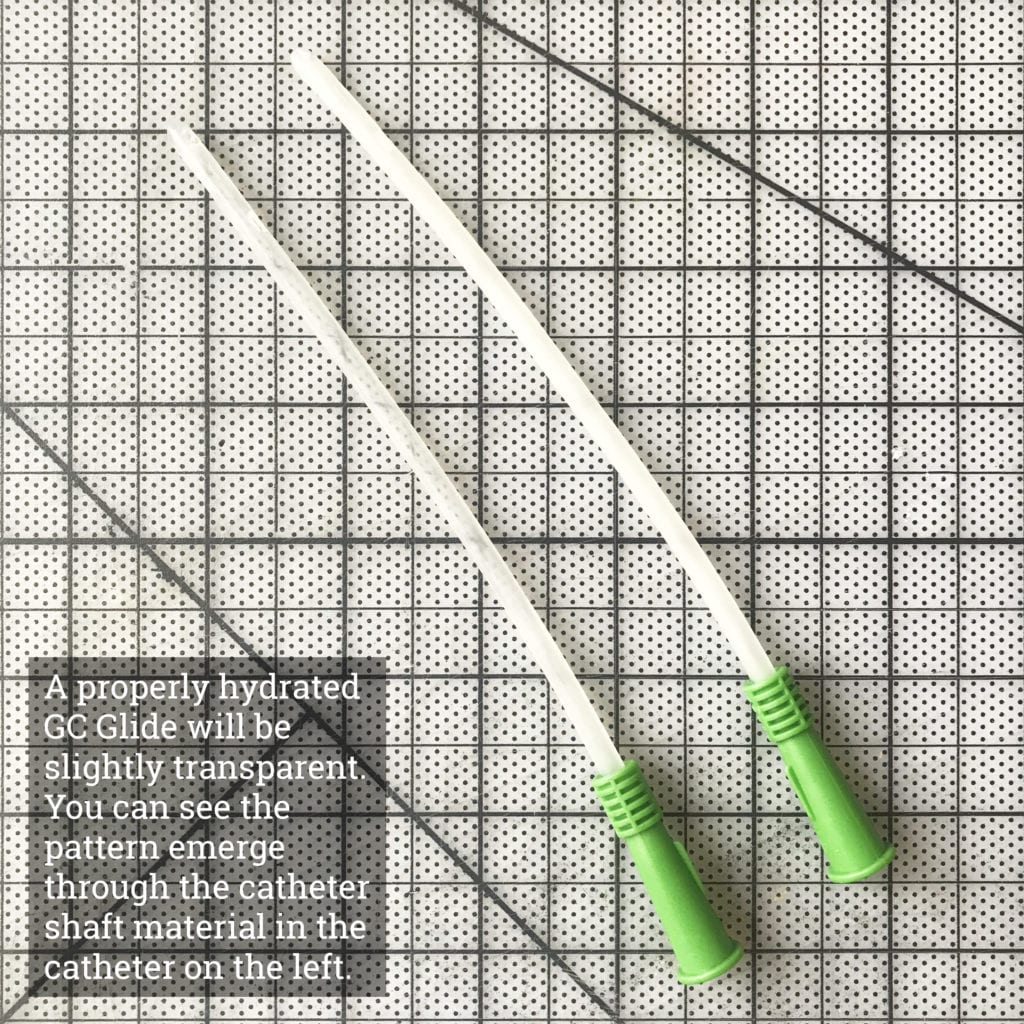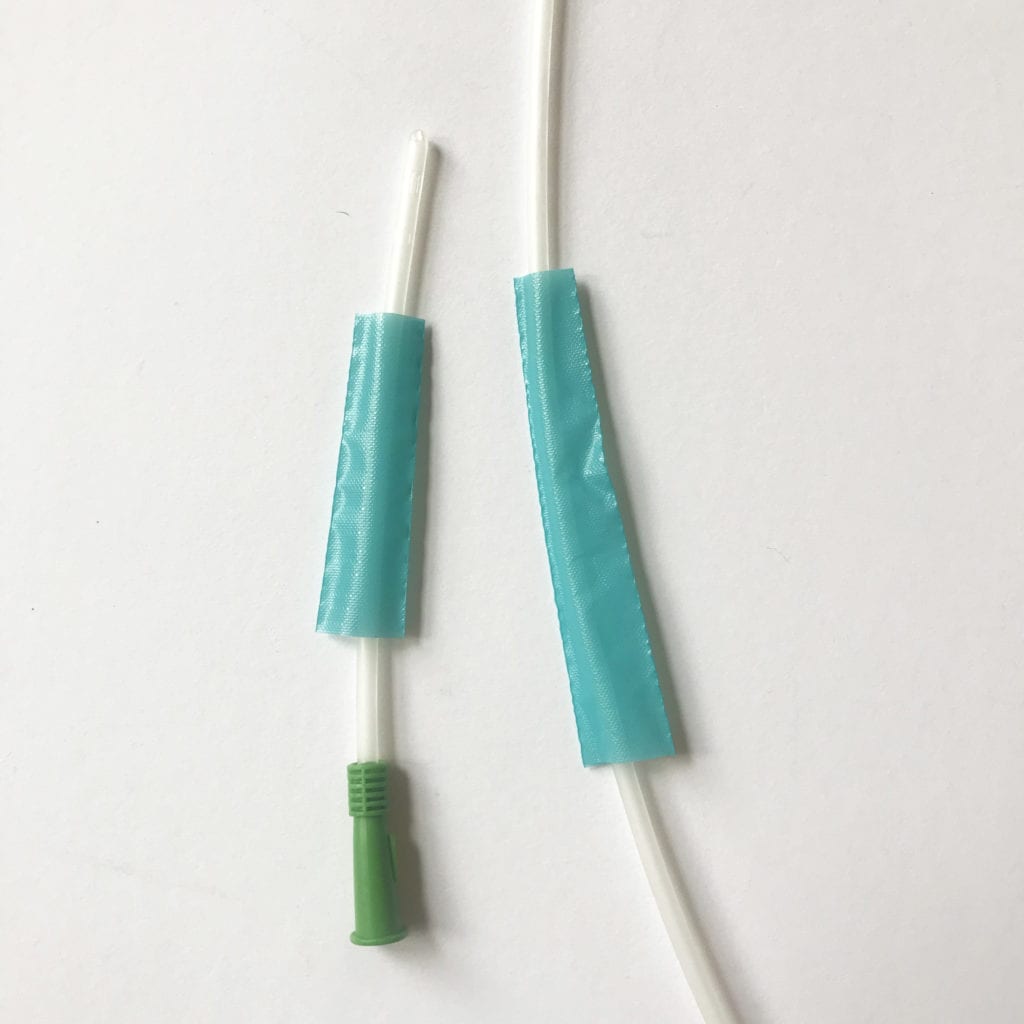Convatec GC Glide™

Product Overview
Available Lengths: 16 inches (Male); 5.9 to 7.9 inches* (Female)
Available Sizes: Fr 8, 10, 12, 14, 16, 18 (Male only)
Available Tips: Coudé and Standard
Pros
A stiffer catheter makes insertion easier.
Comes with an insertion sleeve (they call it no-touch, which it isn’t, but it’s still helpful).
Thoughtful packaging makes managing catheterization easier, even with limited dexterity.
Our Verdict
The GC Glide™ is a solid hydrophilic catheter, with good stiffness and thoughtful packaging that mitigates some, but not all, of the potential causes of UTI.
Cons
The coating can dry out relatively quickly and become sticky.
Material
GC Glide™ catheters are hydrophilic catheters that are made out of a material called polyolefin-based elastomer (POBE). Compared to the PVC that is used in the uncoated GentleCath™ catheters and based on promotional material online, polyolefins generally exhibit good biocompatibility (meaning that it doesn’t harm living tissue). POBE is a catch-all term, however, so it’s hard to comment on the specific material used for this catheter.
Flexibility

This catheter is a stiff one! The female catheter droops down by 0 inches when held by the funnel, making it the stiffest catheter that we’ve tested thus far. The male catheter droops 8.25 inches while extending 11 inches. While lubrication isn’t really a concern for hydrophilic catheters, this relatively high stiffness makes it easier to insert these catheters into the body. A drawback of very stiff catheters is that they may make urethral injury more likely (this paper specifically focused on indwelling catheters, but the logic still applies here).

Packaging
Packaging is one of the areas where the GC Glide™ really shines. It’s low-dexterity friendly, with punched out holes that make it easy to hook the packaging around the thumbs and pull apart. It has a teal sticker on it that peels off to reveal some double-sided tape that can be used to stick the packaging to a bathroom wall, which reduces clutter in the bathroom (always a good thing).
The catheter is packaged with a sachet of sterile water and a “no-touch” sleeve (more on both of those later). The packaging for the units that we reviewed was fairly robust – we popped the sachet of water and the packaging didn’t leak at all, even 12 hours later. This means that if the catheters are rolling around in your bag and the sachet pops, it’s less of a concern that the water will get everywhere – so long as the packaging isn’t punctured somehow.
Lubrication
Hydrophilic catheters are generally easier to lubricate than their uncoated counterparts, and that’s true for the GC Glide™. To lubricate this catheter, you pop the sachet of sterile water and rock the packaging back and forth a few times to ensure coverage. Super simple! While many of ConvaTec’s competitors use a material called PVP to lubricate their hydrophilic catheters, the GC Glide’s regulatory filing suggests that these catheters are rendered slippery through an additive that is directly added to the base catheter material. Promotional material claims that this FeelClean™ technology results in less of a mess when using these catheters.
Depending on your dexterity level, it may be tough to pop the sachet; if squeezing it between your thumb and other fingers doesn’t work, try to pop it between your palms or between your hand and your thigh.

The instructions for this catheter recommend using it within 1-2 minutes of popping the sachet and opening the packaging, and that was consistent with our testing experience. After about 2 minutes, the catheter was noticeably drier and stickier. The coating does seem to wear out faster when it rubs against a surface – so it’s possible that the catheter gets stickier and harder to insert as it travels up the urethra. That stickiness could potentially lead to urethral damage, so if you’re using a hydrophilic catheter, make sure that you use it pretty quickly after wetting it.
Insertion
The GC Glide™ comes with a blue “no touch” sleeve that’s textured so that it can be gripped while wet. This thin plastic sleeve allows you to insert the catheter into your body without touching it with your hands. This type of sleeve tends to be more useful for men because their catheters are so much longer than women’s catheters. When using a sleeve like this, you’re meant to apply pressure to the catheter while it’s inside of you by holding more firmly onto the shaft of the penis – that lets you slide the sleeve towards the funnel and push more of the catheter into your body by slightly releasing your penis while gripping and pushing the catheter in with your other hand.

This type of sleeve isn’t truly no-touch, because it allows the catheter to come in contact with the urethral meatus – which is the medical term for the area surrounding the urethral opening. This area, along with the first half inch or so of the urethra, is thought to house the germs that can cause urinary tract infections – so for a system to truly be no touch, it needs to help you avoid contacting that part of your body with the catheter.
The bottom line is that while the sleeve does help to reduce one cause of contact contamination, don’t buy into the marketing hype and believe that it mitigates all of the potential causes of it. You’ll still need to take precautions to prevent infection!
Adverse Events
Over the course of 2019, 15 complaints were registered with the FDA about the GC Glide line of catheters. A few of these reports have absolutely no details included with them, but 11 of them reported issues with the manufacturing, where the catheter was trapped in the product welding.

The review of FDA Medical Device Reports from 2019 provides a limited snapshot of recent product performance in the marketplace.